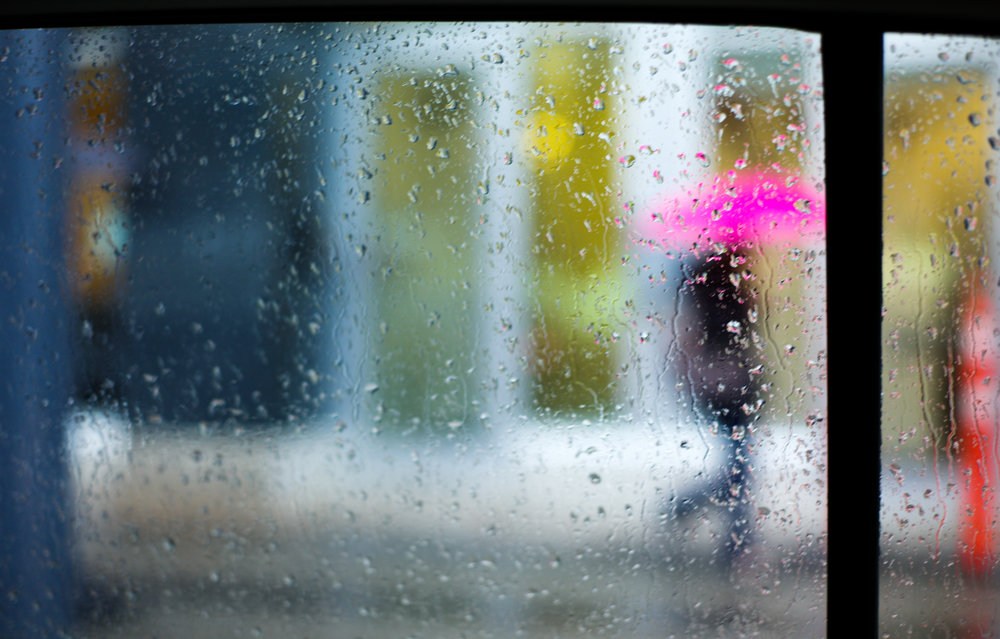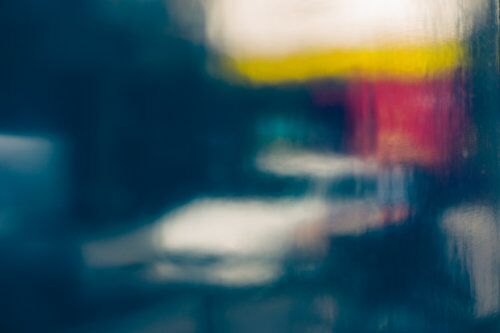A Conversation with Larry Simon, March Featured Artist
“A Pink Umbrella”
What are your earliest memories of art? How did you become an artist yourself?
I was lucky enough that my mom opened my senses to both art and music at a young age—but the moment of discovery which sticks in my mind is a high school field trip to the Art Institute. I saw “Nighthawks” by Edward Hopper and ... wow.
With my lunch money, I ran and bought a small print in the museum shop which I immediately framed.
For better or worse, I’m definitely 100% right brain, and have always immersed myself in creative pursuits, so logic tends to go out the window. After working briefly as a sportswriter, I ended up as an advertising copywriter, then creative director, working with some very talented colleagues and photographers and filmmakers along the way. I really think all this exposure to fine work soaked into my mind so that when I picked up a camera to simply record my travels, something a little more than snapshots emerged.
What has been your evolution as an artist?
I wish I could say something quite grand, like “I studied art in Florence”, but my journey is much more pedestrian. When I started traveling during my freelance years, I bought a used Leica camera because: 1) All my photographer heroes bought one when they started getting serious about photography, and 2) I love the process of roaming foreign cities making photographs of seemingly quotidian moments and objects just to see what they’d look like photographed, as Garry Winogrand once said.
After a day’s wandering, I’d send what I called ‘email postcards’ of my photographs to close friends. Several were artists who encouraged me to organize my images and start showing them. So finally, I did. First in outdoor art fairs, then indoor shows and now in Vivid Gallery, for which I am grateful. Of course, there’s been lots of trial-and- error along the way, even what I’d call some devolution at times. It’s taken a while, but I’ve learned—and am still learning—that you must create and send out to the world the work you love most and never what you think others might like.
“Morning, A Farm in Scotland 1”
Are there any artists who have inspired and influenced you in your work? If so, who are they?
There are four who, at this moment, truly inspire and inform what I feel and do: painter Gerhard Richter, pianist Alfred Brendel, author Haruki Murakami, and photographer Saul Leiter.
Can you describe your process for creating a work?
For me, the key is to not have an agenda when I set out, so the making of photographs becomes a purely meditative experience. It’s my mute button. Using a rangefinder camera with manual focus helps, because it forces me to slow down and consider a scene that might make an interesting image. When I’m roaming streets of foreign cities--my favorite places to carry a camera--I often find myself in perfect silence as I focus on a subject, almost as if using a sketchbook. That’s when I realize I’ve tuned out everything in the world but me and what I’m seeing through the rangefinder.
“I Drive a White Car”
You describe yourself as a photographic artist. How did you come to work in this style and how do you choose your subjects? .
My images have been described by viewers as painterly, and I admit, I love this description. There is a sense of dreaminess, even mystery, that seems to show up when I am not looking for it. For me, this is something different than a typical street photograph. I am not someone who carries a camera everywhere, always looking for something, anything, to capture. For whatever reason, something always appears that wants to be photographed. I think the true making of an image is when the subject captures me.
The idea of making a photograph more painterly first came to me in Venice, which I describe in the next answer, so please read on!
You portray subjects with a combination of sharp and soft focus. Can you talk a little bit about your interest in this?
This happened during a month-long stay in Venice, where I played with soft focus when I tired of shooting gondolas and laundry hanging in the side canals. I can still see myself standing on the Accademia Bridge, focusing on a gondola, and suddenly deciding to unfocus on it. What might happen? I liked the result, because the image of the gondola piloted by the gondolier becomes a dreamy, albeit blurry, tale that may just draw us in more deeply. We can’t quite make out what it is--or can we? The ambiguity appeals to me.
This blend of sharp and soft focus fuels my fascination with our Inner Landscape, a dreamlike place where our logical side can’t always fill in the blanks. These are the narratives I discover as I make photographs and assemble photo collages. Sharp focus or soft, there’s an idea of a composed, surreal scene that might well have appeared in the hours when we dream. I think sometimes what we can’t quite make out or fully understand offers a more compelling story.
“What I Saw One Morning 1”
Where do you see your work going from here?
Photo collages, where I take two unrelated photographs from two different places and put them together to tell a story, are something I have been working on. And I also have been using favorite poems in conjunction with some images, laying the words over the image, or in the margin.
Photography is an interesting world because anyone can take a good photograph today, which pushes me to make more compelling work that could only have been made by me, if that makes any sense. My previous life in advertising was about making sure each ad was built on a creative idea, and this is still an important component of every piece I make. The image must have an idea, and it must tell a story, whatever form it takes.




